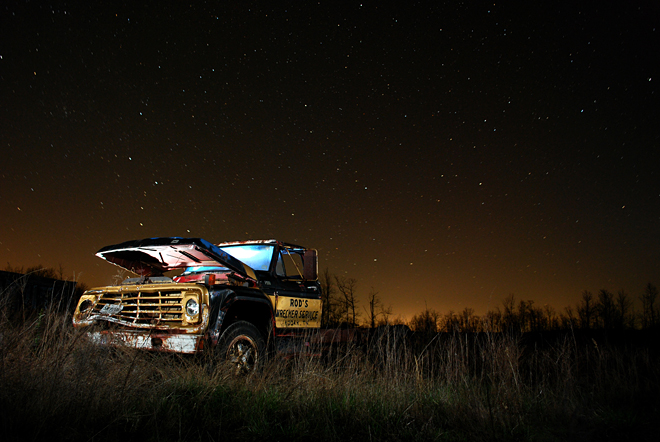
Under the stars. Made on March 29, 2009.
Only a handful of times do I recall being in the presence of something spectacular with a camera in hand and thinking to myself, "Don't screw this up." The first time it happened, I screwed up. I was photographing the lighthouse in Escanaba, Michigan at sunset. After the sun slipped below the horizon, the sky exploded in a golden afterglow, bathing everything in an eerie yellow light. I shot two rolls of film of everything I could to capture the otherworldly sights before me. When the film came back from the photo finisher, I was angry -- they had managed to make all of the shots look, well, ordinary. Where was the yellow?
I stormed back to the lab and asked why they printed the pictures that way. "We just print what's on the negatives," was the reply. Determined to show these morons the errors of their ways, I took the negatives to another lab and asked for a contact sheet -- straight prints, no adjustments, no hank-panky from smartypants technicians to ruin my shots. To my dismay, there was no yellow to be seen on the contact sheet either -- actually, there was almost nothing to be seen at all. I thought back to how I metered the exposure in the golden twilight and realized I compensated for the diminishing light in the wrong direction -- instead of underexposing from the meter reading, I overexposed by two stops. I basically was the proud owner of two rolls of nothing. The fact that the first lab got any pictures to come out at all should have earned them a medal, not my scorn.
Where was I going with that story? Oh, yeah. For most of us shutterbugs, the spectacular happens only very rarely. Unless maybe you live on a mountaintop or a rainforest or are a storm chaser or something. The rest of us lead fairly ordinary lives. For us, the trick is to find ways to make the ordinary look extraordinary. It can be done. Either through relationship of the subject to its surroundings, angle, lighting, distance -- the name of the game is to try to look at old things in new ways.
Visiting family in Tennessee last spring, I became enamored with some old trucks abandoned in a field nearby. I spent night after night with a tripod and a hand held flash unit trying to get something interesting to show up on my camera. I'd set the camera for a long exposure, then trigger the flash from different angles to create the picture. After two nights I didn't have much to show for my efforts.
The third night, I set out again. When I shoot at night, I usually set the camera low on a tripod -- usually no more than a foot off the ground. It makes the night look more imposing. As for exposure, instead of keying on the trucks, as I had the previous nights, I set the exposure to catch the night sky. While the camera's shutter opened for the 30 seconds necessary to get the stars to register, I ran around the truck with my flash, firing six or seven bursts of light, finishing off with a burst in the cab with a blue filter placed over the flash head.
Other than adjusting contrast, the image above is as it came out of the camera. The orange glow in the sky came courtesy of the lights in a town about ten miles away.
So an ordinary truck in an ordinary setting (in Tennessee, at least) became extraordinary by picking the time and method of making the image.
Photograph © 2009 James Jordan.




2 comments:
Well, hard work paid off! Yhis is a beautiful image of a ghost truck. The orange glow on a horizon is a definite plus. Well done!....
Love it.
it's like a real life scene from the movie, "Cars"! do you know the character Tow Mater?
Post a Comment